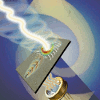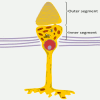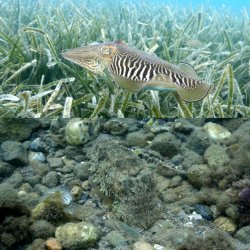-
Viewpoint on 'IONS'
Viewpoint on 'Scientific Literacy'
- Proudly sponsored by
-


-
A New Twist to Optical Detectors

A new arrival in the family of optical detectors gives a new twist to the detection of the orbital angular momentum of light. This could make classical and quantum optical communications even easier.
-
Snapshots of Electrons in Motion

Recent, groundbreaking experiments have permitted the study of the motion of electrons in atoms right after ionization. This leads the way to a better understanding and control of the motion of electrons in atoms and molecules.
-
Restless Cells in the Human Eye

The cone cells in the human eye make it possible for us to enjoy a world full of color. A new technique helps us understand these cells better by measuring their growth in the eyes of a living person.
Volume 16 Story 2 - 11/1/2012

Fee-fi-fo-fish
I smell the presence of a cuttlefish,
Be it alive, or be it dead
I’ll find its tentacles on the seabed.
These might well be the thoughts of a natural predator of cuttlefish. In fact, despite their lack of color vision, cuttlefish can blend into the seabed and take on any pattern or color. Looking for them, therefore, is no easy job — even for a predator with the natural advantage of keen color perception. The stakes are high as a game of hide and seek for survival begins! To fully investigate the effectiveness of the camouflage, an international group of researchers has developed a technique to process images of camouflaged cuttlefish, as if looking at the situation through the eyes of a predator.
A cuttlefish’s camouflage works remarkably well when seen through the human eye, but how can we be sure that it is just as effective against its natural predators? Most animals see the world in a different way from us: for example, bees can see ultraviolet radiation, mantis shrimps detect the polarization of light, and many snakes identify their prey through thermal radiation alone. In order to fool the eyes of their predators, cuttlefish have developed the ability to blend into their environment, dynamically adjusting colors, contrast, and even patterns. Their "color-changing abilities have been appreciated since Aristotle’s time," points out Chuan-Chin Chiao, one of the researchers involved in this work, from the National Tsing Hua University (Hsinchu, Taiwan). Cuttlefish are indeed nature’s true camouflage artists!
"Our findings provide strong support that cuttlefish are capable of hiding in plain sight of their visual predators," says Chiao. The team of researchers came to this conclusion by analyzing hyperspectral images of cuttlefish camouflaged on a variety of natural backgrounds. While images in our brain are formed using only three different color bands (red, green and blue), hyperspectral images are formed by recording the same scene in hundreds of different color bands in a broad region of the electromagnetic spectrum. The viewpoint of a selected predator can therefore be reconstructed by combining the appropriate color bands from the hyperspectral image. And this is exactly what Chiao and colleagues did: in this way, the researchers were able to fully reconstruct the predator’s visual system and quantify the actual effectiveness of the cuttlefish’s camouflage.
According to Chiao, this research not only "indicates the strong potential of hyperspectral imaging technology to evaluate camouflage body patterns simultaneously," but it also "provides supporting evidence that cuttlefish can produce color-coordinated camouflage on natural backgrounds despite lacking color vision, and that the color aspect of cuttlefish camouflage is highly effective against fish predators." And he adds: "To our knowledge, this is the first time that color matching in camouflaged animals is visualized more realistically through the eyes of their potential predators."
"Camouflage is of course inherently interesting to us," comments Thomas Cronin at the University of Maryland, USA. According to Cronin, in fact, studying this is important for improving our general understanding of ecological interactions, such as predator-prey interactions, and of sensory functions, such as that of visual optimization. "This is the first study to apply simple statistical treatments based on actual visual systems of potential predators to evaluate the effectiveness of camouflage pattern and color simultaneously." Finally, this research, he concludes, is of special interest for applications where it is required to find or hide critical objects in complex backgrounds, such as in spotting or concealing camouflaged objects in security situations or military operations.

Hide and Seek
Every morning, on the seabed, a cuttlefish wakes up. It knows it must camouflage itself to fool its predators. Every morning, on the seabed, a predator fish wakes up. It knows it must keep its eyes peeled, if it wants to eat. The game for survival is on. Who will win?
Spot the cuttlefishes. The cuttlefish in the image (Sepia officinalis) show two distinct body patterns: non-camouflaged (top) and camouflaged (bottom). Can you spot them both? Photo by Roger T. Hanlon.
Fee-fi-fo-fish
I smell the presence of a cuttlefish,
Be it alive, or be it dead
I’ll find its tentacles on the seabed.
These might well be the thoughts of a natural predator of cuttlefish. In fact, despite their lack of color vision, cuttlefish can blend into the seabed and take on any pattern or color. Looking for them, therefore, is no easy job — even for a predator with the natural advantage of keen color perception. The stakes are high as a game of hide and seek for survival begins! To fully investigate the effectiveness of the camouflage, an international group of researchers has developed a technique to process images of camouflaged cuttlefish, as if looking at the situation through the eyes of a predator.
A cuttlefish’s camouflage works remarkably well when seen through the human eye, but how can we be sure that it is just as effective against its natural predators? Most animals see the world in a different way from us: for example, bees can see ultraviolet radiation, mantis shrimps detect the polarization of light, and many snakes identify their prey through thermal radiation alone. In order to fool the eyes of their predators, cuttlefish have developed the ability to blend into their environment, dynamically adjusting colors, contrast, and even patterns. Their "color-changing abilities have been appreciated since Aristotle’s time," points out Chuan-Chin Chiao, one of the researchers involved in this work, from the National Tsing Hua University (Hsinchu, Taiwan). Cuttlefish are indeed nature’s true camouflage artists!
"Our findings provide strong support that cuttlefish are capable of hiding in plain sight of their visual predators," says Chiao. The team of researchers came to this conclusion by analyzing hyperspectral images of cuttlefish camouflaged on a variety of natural backgrounds. While images in our brain are formed using only three different color bands (red, green and blue), hyperspectral images are formed by recording the same scene in hundreds of different color bands in a broad region of the electromagnetic spectrum. The viewpoint of a selected predator can therefore be reconstructed by combining the appropriate color bands from the hyperspectral image. And this is exactly what Chiao and colleagues did: in this way, the researchers were able to fully reconstruct the predator’s visual system and quantify the actual effectiveness of the cuttlefish’s camouflage.
According to Chiao, this research not only "indicates the strong potential of hyperspectral imaging technology to evaluate camouflage body patterns simultaneously," but it also "provides supporting evidence that cuttlefish can produce color-coordinated camouflage on natural backgrounds despite lacking color vision, and that the color aspect of cuttlefish camouflage is highly effective against fish predators." And he adds: "To our knowledge, this is the first time that color matching in camouflaged animals is visualized more realistically through the eyes of their potential predators."
"Camouflage is of course inherently interesting to us," comments Thomas Cronin at the University of Maryland, USA. According to Cronin, in fact, studying this is important for improving our general understanding of ecological interactions, such as predator-prey interactions, and of sensory functions, such as that of visual optimization. "This is the first study to apply simple statistical treatments based on actual visual systems of potential predators to evaluate the effectiveness of camouflage pattern and color simultaneously." Finally, this research, he concludes, is of special interest for applications where it is required to find or hide critical objects in complex backgrounds, such as in spotting or concealing camouflaged objects in security situations or military operations.
Giorgio Volpe
2012 © Optics & Photonics Focus
GV is currently working on his doctoral thesis at ICFO - The Institute of Photonic Sciences, Barcelona (Spain).

Chuan-Chin Chiao, J. Kenneth Wickiser, Justine J. Allen, Brock Genter & Roger T. Hanlon, Hyperspectral imaging of cuttlefish camouflage indicates good color match in the eyes of fish predators, PNAS (2011) 108, 9148–9153 (link).